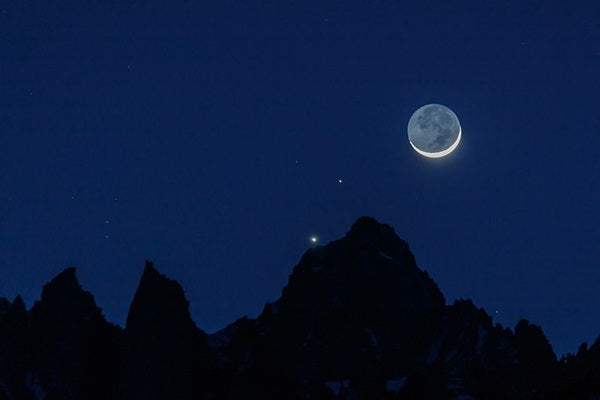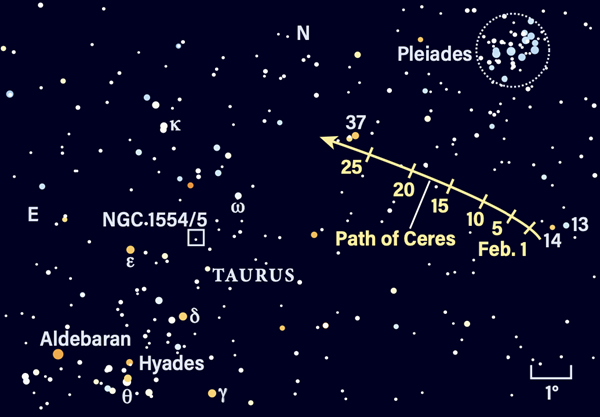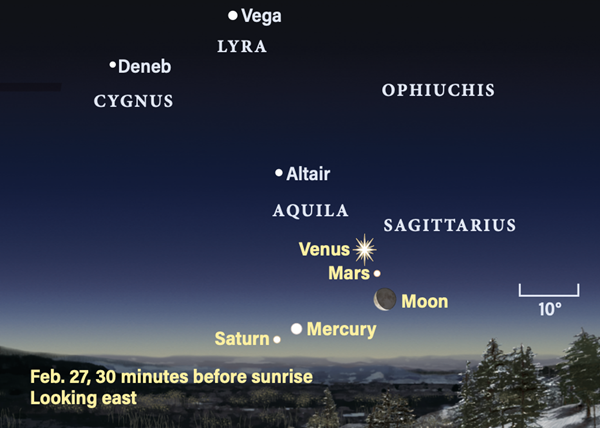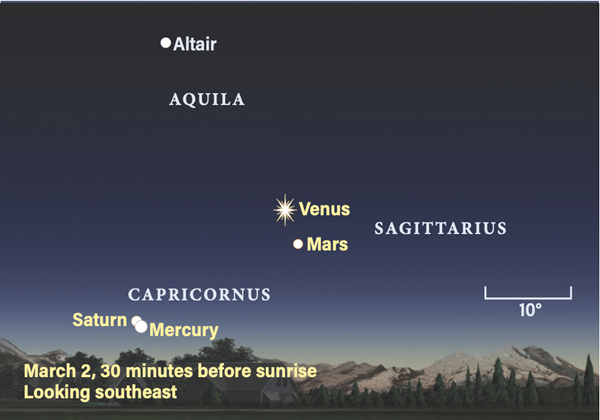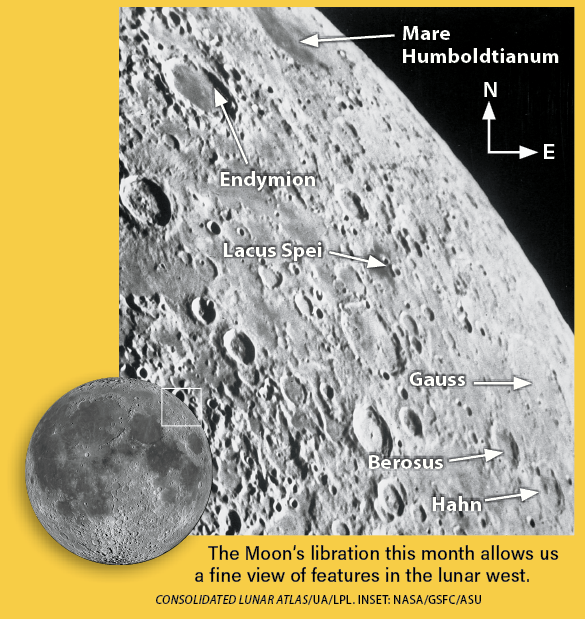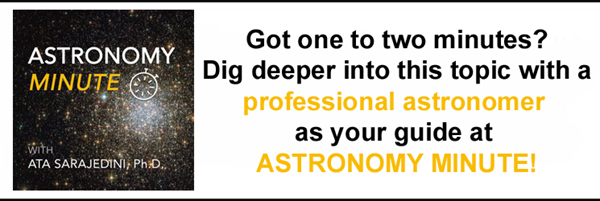Friday, February 25
Tonight, we look to Cassiopeia the Queen after sunset to catch a glimpse of the open star cluster M103. Discovered not by Messier but by his colleague Pierre Méchain, this young cluster of stars glows softly at magnitude 7.4 and spans about 6′ from its position roughly 1° northeast of Ruchbah (Delta [δ] Cassiopeiae).
Although too faint to see unaided, M103 is easy to observe with binoculars or any small scope. Many skygazers think it resembles a small fan or arrowhead of stars, tipped with the triple star Struve 131. This system is not, however, associated with the cluster, and merely lies in the same field. And if you’re an astrophotographer, this is definitely a target not to be missed: In photos, the cluster’s single red giant star suddenly pops out to shows its colors.
Sunrise: 6:39 A.M.
Sunset: 5:48 P.M.
Moonrise: 2:56 A.M.
Moonset: 12:03 P.M.
Moon Phase: Waning crescent (30%)
*Times for sunrise, sunset, moonrise, and moonset are given in local time from 40° N 90° W. The Moon’s illumination is given at 12 P.M. local time from the same location.
Saturday, February 26
The Moon reaches perigee — the closest point to Earth in its orbit — at 5:25 P.M. EST. Our satellite will then sit 228,533 miles (367,788 kilometers) away.
Today, let’s turn our gaze toward Taurus the Bull, already high in the southwest after sunset. It should be easy to find the Pleiades (M45), a sparking, small dipper-shaped cluster of stars in the northwestern portion of the constellation. Dwarf planet 1 Ceres, the ruler of the asteroid belt, sits about 4.8° southeast of the Pleiades tonight, traveling northeast as the hours tick by. Today through the 28th, see if you can record the small world’s motion by comparing its position with nearby 37 Tau, which shines at magnitude 4.3 (compared with Ceres’ magnitude 8.5 glow). You should be able to spot movement after just two hours or so, but the more time you let elapse between subsequent observations, the more you’ll notice this distant world’s movement relative to the background stars.
Sunrise: 6:37 A.M.
Sunset: 5:49 P.M.
Moonrise: 4:02 A.M.
Moonset: 1:06 P.M.
Moon Phase: Waning crescent (20%)
Sunday, February 27
If you can bring yourself to get up early on a weekend, the planets will richly reward you with a wonderful lineup that includes the crescent Moon this morning.
The Moon passes 9° south of Venus at 1 A.M. EST, although both are below the horizon at that time. Our satellite then passes 4° south of Mars at 4 A.M. EST — still invisible to our eyes. But by 5:30 A.M. EST on the East Coast, it’s a different story: Venus, Mars, and the Moon have all cleared the horizon, standing in a line in eastern Sagittarius. Give it another hour in the Midwest, and you’ll see the same sight.
Regardless of your location, by 30 minutes before sunrise, two more planets have joined the scene. Starting at the top, Venus sits nearly 20° high and shines at magnitude –4.8. Through a telescope, it is 37 percent lit. Below Venus is Mars, just over 13° high and a dimmer magnitude 1.3. The Red Planet now sits a little less than 5° northwest of the 26-day-old Moon, which is just 13 percent illuminated and 9° above the horizon.
Look to the lower left (east) of the Moon, and much closer to the horizon are Mercury — 4° high and magnitude 0 — and Saturn — just 2.5° high and magnitude 0.7. You might need binoculars or a telescope to spot the ringed planet in the growing twilight, but take care to stop scanning the horizon with any kind of optical aid several minutes before the Sun rises to avoid accidental damage to your eyes.
Sunrise: 6:36 A.M.
Sunset: 5:50 P.M.
Moonrise: 4:58 A.M.
Moonset: 2:16 P.M.
Moon Phase: Waning crescent (12%)
Monday, February 28
Mercury reaches aphelion today, less than two weeks after its greatest western elongation. The solar system’s smallest planet is now 75 percent lit and rises around 5:40 A.M. local time. Through a telescope, you’ll see it spans 6″. If you got a look at the eastern sky yesterday, you may notice today that Mercury and Saturn are now closer together as well — they’ve moved from 4° apart on the 27th to less than 3° apart today. The pair is headed for a close conjunction in just a few days, so stay tuned.
The Moon has also moved, continuing its trek eastward along the ecliptic. Our satellite is now just 7 percent lit. Look for earthshine — reflected sunlight bouncing off Earth — lighting up the portion of the Moon’s face otherwise in shadow. The Moon passes 4° south of Mercury at 3 P.M. EST today, then passes 4° south of Saturn at 7 P.M. EST.
Sunrise: 6:34 A.M.
Sunset: 5:51 P.M.
Moonrise: 5:45 A.M.
Moonset: 3:31 P.M.
Moon Phase: Waning crescent (5%)
Tuesday, March 1
Let’s begin March with a look at the American Association of Variable Star Observers’ monthly featured variable star: Betelgeuse. This famous luminary marks the right shoulder of Orion the Hunter, assuming he is drawn facing us. It’s a bright, prominent star, visible even from most light-polluted areas. Betelgeuse is an aging star called a red giant — you may notice its reddish color even with the naked eye, and its hue becomes more apparent when viewed with binoculars or a telescope. An hour after sunset, Orion is already high in the sky. You’ll find Betelgeuse glowing about 57° above the southern horizon, to the upper left (north) of Orion’s famous three-star belt.
If you look up Betelgeuse’s magnitude, you’ll likely see it listed as 0.7. That makes it the 11th brightest star in the sky. But Betelgeuse is, as you may have guessed, a variable star whose magnitude changes from 0.3 at its brightest to 1.1 at its dimmest. The physics behind these changes are complex and result in several timescales for variability ranging from just a few months to a few years. You can spot its changing brightness over time by comparing it to the stars around it: notably magnitude 1.6 Bellatrix (Orion’s left shoulder), magnitude 1.7 Alnitak (the rightmost star in Orion’s Belt — again drawn facing us, so it appears leftmost on the sky), magnitude 2.1 Saiph (Orion’s right knee), and magnitude 0.2 Rigel (Orion’s left knee).
Sunrise: 6:33 A.M.
Sunset: 5:52 P.M.
Moonrise: 6:22 A.M.
Moonset: 4:45 P.M.
Moon Phase: Waning crescent (1%)
Wednesday, March 2
Today is the day! Mercury passes 0.7° south of Saturn at 8 A.M. EST. You can catch the pair half an hour before sunrise, with brighter Mercury just to the south (lower right) of Saturn. The two stand 3.5° high at that time and will continue to rise as twilight brightens the sky. Mercury has now brightened to magnitude –0.1, while Saturn remains magnitude 0.7 (and will do so all month). The two planets are close enough that you can enjoy their juxtaposition with either binoculars or a telescope — as always, make sure to stop using these optical aids at least several minutes before sunrise.
As long as you’re up, take the time to look 22° west along the ecliptic to catch bright Venus, which shines at an unmissable magnitude –4.7. Now nearly 5° to Venus’ lower right (south), Mars is still magnitude 1.3.
New Moon occurs at 12:35 P.M. EST, leaving us with a nicely dark nighttime sky for the rest of the week.
Sunrise: 6:31 A.M.
Sunset: 5:53 P.M.
Moonrise: 6:54 A.M.
Moonset: 5:58 P.M.
Moon Phase: New
Thursday, March 3
With no Moon visible tonight, it’s a perfect time to try your luck at spotting the sporadic meteors that occasionally flash through our sky. Not associated with any particular shower, these pieces of space dust are simply random debris that strike Earth’s atmosphere and briefly flare up as they disintegrate. At this time of year, the sporadic background rate is roughly 6 meteors per hour. The best time to search is before dawn because at this time, Earth’s rotation is working in your favor as your hemisphere strikes floating debris head-on. Still, if you prefer nighttime observing, you may still see chance meteor streaks — or spot the steadily moving dot of a satellite orbiting overhead.
At this time of year, early evening just after sunset is also the right time to look for the zodiacal light, generated by sunlight scattering off dust in the plane of the solar system. This creates a soft, glowing cone of light rising up from the western horizon, spreading through Pisces, Aries, and Taurus. You’ll need a dark observing site to see it, and using peripheral vision to view out of the corner of your eye may further help this gentle light stand out from the background.
Sunrise: 6:30 A.M.
Sunset: 5:54 P.M.
Moonrise: 7:21 A.M.
Moonset: 7:07 P.M.
Moon Phase: Waxing crescent (1%)
Friday, March 4
Just two days past New, our Moon is now a 6-percent-lit crescent setting about two hours after sunset. Take that time to turn a telescope on our satellite’s eastern limb and enjoy features such as Mare Humboldtianum, the dark splotch of Lacus Spei, and the craters Gauss, Hahn, and Berosus. This early in the lunar month, those craters are sporting bright rims drenched in sunshine, while their floors remain in dark shadow.
But what’s really interesting to watch is the way the Moon’s eastern limb will tilt away from us in the coming days. Compare your view tonight to that over the next week or so, and you’ll see these features appear to rock back and away with each passing day. What’s going on? You’re seeing a phenomenon called libration, which causes the Moon to appear to “nod” back and forth or up and down as it orbits Earth. In this case, we have the opportunity to see more of the lunar west, but less of the lunar east.
Sunrise: 6:28 A.M.
Sunset: 5:55 P.M.
Moonrise: 7:46 A.M.
Moonset: 8:13 P.M.
Moon Phase: Waxing crescent (5%)

